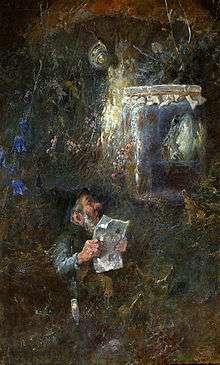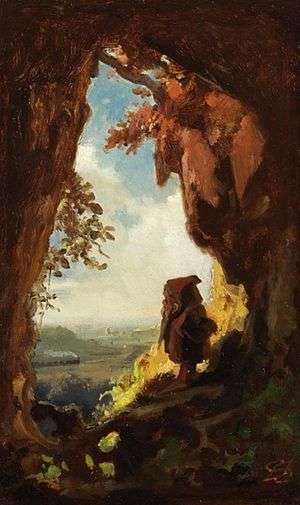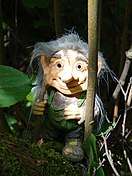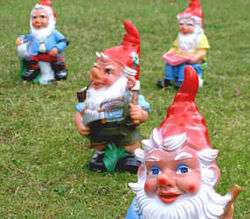Gnome
A gnome /noʊm/[1] is a mythological creature and diminutive spirit in Renaissance magic and alchemy, first introduced by Paracelsus in the 16th century and later adopted by more recent authors including those of modern fantasy literature. Its characteristics have been reinterpreted to suit the needs of various story tellers, but it is typically said to be a small humanoid that lives underground.[2]
 Gnom mit Zeitung und Tabakspfeife (English: Gnome with newspaper and tobacco pipe) by Heinrich Schlitt (1923) | |
| Grouping | Diminutive spirit |
|---|---|
History
Origins
The word comes from Renaissance Latin gnomus, which first appears in A Book on Nymphs, Sylphs, Pygmies, and Salamanders, and on the Other Spirits by Paracelsus, published posthumously in Nysa in 1566 (and again in the Johannes Huser edition of 1589–1591 from an autograph by Paracelsus).[3]
The term may be an original invention of Paracelsus, possibly deriving the term from Latin gēnomos (itself representing a Greek γη-νομος, literally "earth-dweller"). In this case, the omission of the ē is, as the Oxford English Dictionary (OED) calls it, a blunder. Paracelsus uses Gnomi as a synonym of Pygmæi and classifies them as earth elementals. He describes them as two spans high, very reluctant to interact with humans, and able to move through solid earth as easily as humans move through air.[4] The chthonic, or earth-dwelling, spirit has precedents in numerous ancient and medieval mythologies, often guarding mines and precious underground treasures, notably in the Germanic dwarfs and the Greek Chalybes, Telchines or Dactyls.[2]
In Romanticism and modern fairy tales
The English word is attested from the early 18th century. Gnomes are used in Alexander Pope's "The Rape of the Lock". The creatures from this mock-epic are small, celestial creatures which were prudish women in their past lives, and now spend all of eternity looking out for prudish women (in parallel to the guardian angels in Catholic belief). Other uses of the term gnome remain obscure until the early 19th century, when it is taken up by authors of Romanticist collections of fairy tales and becomes mostly synonymous with the older word goblin.
Pope's stated source, the French satire (by Nicolas-Pierre-Henri de Montfaucon de Villars, the abbot of Villars) Comte de Gabalis (1670) describes gnomes as such:
"The Earth is filled almost to the Center with Gnomes or Pharyes, a People of small Stature, the Guardians of Treasures, of Mines, and of Precious Stones. They are Ingenious, Friends of Men, and easie to be commandded. They furnish the Children of the Sages with as much Money, as they have need of; and never ask any other Reward of their Services, than the Glory of being Commanded. The Gnomides or Wives of these Gnomes or Pharyes, are Little, but very Handson; and their Habit marvellously Curious."[5]
Villars used the term gnomide to refer to female gnomes (often "gnomid" in English translations).[6] Modern fiction instead uses the word "gnomess" to refer to female gnomes.[7][8]
In 19th-century fiction, the chthonic gnome became a sort of antithesis to the more airy or luminous fairy. Nathaniel Hawthorne in Twice-Told Tales (1837) contrasts the two in "Small enough to be king of the fairies, and ugly enough to be king of the gnomes" (cited after OED). Similarly, gnomes are contrasted to elves, as in William Cullen Bryant's Little People of the Snow (1877), which has "let us have a tale of elves that ride by night, with jingling reins, or gnomes of the mine" (cited after OED).
One of the first movements in Mussorgsky's 1874 work Pictures at an Exhibition, named "Gnomus" (Latin for "The Gnome"), is written to sound as if a gnome is moving about, his movements constantly changing in speed.
Franz Hartmann in 1895 satirized materialism in an allegorical tale entitled Unter den Gnomen im Untersberg. The English translation appeared in 1896 as Among the Gnomes: An Occult Tale of Adventure in the Untersberg. In this story, the Gnomes are still clearly subterranean creatures, guarding treasures of gold within the Untersberg mountain.
As a figure of 19th-century fairy tales, the term gnome became largely synonymous with other terms for "little people" by the 20th century, such as goblin, brownie, kobold, leprechaun, Heinzelmännchen and other instances of the "domestic spirit" type, losing its strict association with earth or the underground world.
Cultural references
Modern fantasy literature
- Creatures called gnomes have been used in the fantasy genre of fiction and later gaming since the mid-nineteenth century, typically in a cunning role, e.g. as an inventor.[9]
- In L. Frank Baum's Oz series (created 1900 to 1914), the Nomes (so spelled), especially their king, are the chief adversaries of the Oz people. They are ugly, hot-tempered, immortal, round-bodied with spindly legs and arms, have long beards and wild hair, live underground, and are the militant protectors/hoarders of jewels and precious metals. Baum does not depict any female gnomes. Ruth Plumly Thompson, who continued the series (1972 to 1976) after Baum's death, reverted to the traditional spelling.
- L. Frank Baum also featured the classical gnomes in his book The Life and Adventures of Santa Claus. They are in charge of watching over the rocks and their king is part of the Council of Immortals. In addition, they also created the sleigh bells for Santa Claus' reindeer.
- J. R. R. Tolkien, in the legendarium (created 1914 to 1973) surrounding his Elves, uses "Gnomes" as the initial and later dropped name of the Noldor, the most gifted and technologically minded of his elvish races, in conscious exploitation of the similarity with the word gnomic. Gnome is thus Tolkien's English loan-translation of the Quenya word Noldo (plural Noldor), "those with knowledge". Tolkien's "Gnomes" are generally tall, beautiful, dark-haired, light-skinned, immortal, and typically wise but suffer from pride, tend towards violence, and have an overweening love of the works of their own hands, particularly gemstones. Many of them live in cities below ground (Nargothrond) or in secluded mountain fortresses (Gondolin). He uses "Gnomes" to refer to both males and females. In The Father Christmas Letters (between 1920 and 1942), which Tolkien wrote for his children, Red Gnomes are presented as helpful creatures who come from Norway to the North Pole to assist Father Christmas and his Elves in fighting the wicked Goblins.
- BB's The Little Grey Men (1942) is a story of the last gnomes in England, little wild men who live by hunting and fishing.
- In C. S. Lewis's The Chronicles of Narnia (created 1950 to 1956), the gnomes are sometimes called "Earthmen". live in the Underland, a series of caverns. Unlike the traditional, more human-like gnomes, they can have a wide variety of physical features and skin colours. They are used as slaves by the Lady of the Green Kirtle.
- The Dutch books Gnomes (1976) and The Secret Book of Gnomes (1984), written by Wil Huygen, deal with gnomes living together in harmony. These same books are the basis for a made-for-TV animated film and the Spanish-animated series The World of David the Gnome (as well as the spin-off Wisdom of the Gnomes). The word "gnome", in this case, is used in place of the Dutch kabouter.
- In the Warcraft franchise (1994 to present), particularly as featured in the MMORPG World of Warcraft, gnomes are a race of beings separate from but allied to dwarves and humans, with whom they share the lands of the Eastern Kingdoms. Crafty, intelligent, and smaller than their dwarven brethren, gnomes are one of two races in Azeroth regarded as technologically savvy. It is suggested in lore that the gnomes originally were mechanical creations that at some point became organic lifeforms. In World of Warcraft, gnomes are an exile race, having irradiated their home city of Gnomeregan in an unsuccessful last-ditch effort to drive out marauding foes.[10]
- In J. K. Rowling's Harry Potter series (created 1997 to 2007), gnomes are pests that inhabit the gardens of witches and wizards. They are small creatures with heads that look like potatoes on small stubby bodies. Gnomes are generally considered harmless but mischievous and may bite with sharp teeth. In the books, it is stated that the Weasleys are lenient to gnomes, and tolerate their presence, preferring to throw them out of the garden rather than more extreme measures.
- In A. Yoshinobu’s Sorcerous Stabber Orphen , the European concept of a gnome is used in order to introduce the Far Eastern notion of the Koropokkuru, a mythical indigenous race of small people: gnomes are a prosecuted minority banned from learning wizardry and attending magical schools. [11]
- In Terry Brooks' Shannara series (created 1977 to 2017), gnomes are an offshoot race created after the Great Wars. There are several distinctive classes of gnomes. Gnomes are the smallest race. In The Sword of Shannara they are considered to be tribal and warlike, the one race that can be the most easily subverted to an evil cause. This is evidenced by their allegiance to the Warlock Lord in The Sword of Shannara and to the Mord Wraiths in The Wishsong of Shannara.
- Terry Pratchett included gnomes in his Discworld series. Gnomes were six inches in height but quite strong, often inflicting pain upon anyone underestimating them. One prominent gnome became a Watchman in Ankh-Morpork as the force became more diversified under the command of Sam Vimes, with Buggy Swires appearing in Jingo (novel). Another gnome in the series was Wee Mad Arthur a pest terminator in Feet of Clay (novel).
Music
- "The Laughing Gnome" is a song by English musician David Bowie, released as a single in 1967. It became a hit when reissued in 1973, in the wake of Bowie's commercial success.
- The 1970 album All Things Must Pass by English musician George Harrison has a cover image of the musician sitting among a group of garden gnomes.
- "The Gnome" is a song by Pink Floyd on their 1967 album The Piper at the Gates of Dawn. It is about a gnome named Grimble Gromble.
Games
- In the Dungeons & Dragons fantasy role-playing game, gnomes are one of the core races available for play as player characters.[12]
Derivative uses
Garden gnomes
After World War II (with early references, in ironic use, from the late 1930s) the diminutive figurines introduced as lawn ornaments during the 19th century came to be known as garden gnomes. The image of the gnome changed further during the 1960s to 1970s, when the first plastic garden gnomes were manufactured. These gnomes followed the style of the 1937 depiction of the seven dwarves in Snow White and the Seven Dwarfs by Disney. This "Disneyfied" image of the gnome was built upon by the illustrated children's book classic The Secret Book of Gnomes (1976), in the original Dutch Leven en werken van de Kabouter. Garden gnomes share a resemblance to the Scandinavian tomte and nisse, and the Swedish term "tomte" can be translated as "gnome" in English.
Gnome-themed parks

Several gnome themed entertainment parks exist. Notable ones are:
- The Gnome Reserve, at West Putford near Bradworthy in North Devon, United Kingdom
- Gnomeland, at Watermouth Castle in Berrynarbor, North Devon, United Kingdom
- Gnome Magic Garden, at Colchester, United Kingdom
- The Gnome Village, at Efteling theme park in Kaatsheuvel, Netherlands
- Zwergen-Park Trusetal, in Trusetal, Germany
Gnome parades
Gnome parades are held annually at Atlanta's Inman Park Festival.[13] Numerous one-off gnome parades have been held, including in Savannah, Georgia (April 2012)[14] and Cleveland, Ohio (May 2011).[15]
Metaphorical uses
- The expression "Gnomes of Zürich", Swiss bankers pictured as diminutive creatures hoarding gold in subterranean vaults, was derived from a speech in 1956 by Harold Wilson, and gained currency in the 1960s (OED notes the New Statesman issue of 27 November 1964 as earliest attestation).
- Architect Earl Young built a number of stone houses in Charlevoix, Michigan, that have been referred to as gnome homes.
- A user of Wikipedia or any wiki who makes useful incremental edits without clamouring for attention is called a WikiGnome.[16]
See also
| Wikiquote has quotations related to: Gnomes |
| Wikimedia Commons has media related to Gnomes. |
| Wikisource has the text of the 1911 Encyclopædia Britannica article Gnomes. |
References
- "Gnome". Oxford English Dictionary (3rd ed.). Oxford University Press. September 2005. (Subscription or UK public library membership required.)
- "Gnome". Encyclopædia Britannica Online. Archived from the original on 17 April 2008. Retrieved 12 March 2008.
- Paracelsus (1566). Ex Libro de Nymphis, Sylvanis, Pygmaeis, Salamandris et Gigantibus, etc. Nissae Silesiorum: Ioannes Cruciger.
- Lewis, C. S. (1964). The Discarded Image - An Introduction to Medieval and Renaissance Literature. Cambridge University Press. p. 135. ISBN 0-521-47735-2.
- Montfaucon de Villars, Nicolas-Pierre-Henri (1680). The Count of Gabalis: Or, The Extravagant Mysteries of the Cabalists, Exposed in Five Pleasant Discourses on the Secret Sciences. Translated by Gent, P. A. London: B. M. Printer. pp. 29–30. OCLC 992499594.
- de Montfaucon de Villars, N.-P.-H. (1913) [1670]. Comte de Gabalis. London: The Brothers, Old Bourne Press. OCLC 6624965. Archived from the original on 13 May 2015.
- 2007: Shadow on the Land, page 115
- 2013: Gnomes and Haflings, page 120
- Clute, John; Grant, John (1999). "Elemental". The Encyclopedia of Fantasy. New York: St. Martin's Griffin. pp. 313–314. ISBN 0-312-19869-8.
- Rossi, Matthew (23 April 2014). "Know Your Lore: Gnomes, the inheritors of the future". Engadget. Archived from the original on 31 July 2016. Retrieved 4 July 2016.
- Mizuno, Ryou (2019). Sorcerous Stabber Orphen Anthology. Commentary (in Japanese). TO Books. p. 238. ISBN 9784864728799.
- Tweet, Jonathan (July 2003). Player's Handbook Core Rulebook I v.3.5. Renton WA: Wizards of the Coast.
- Paul, Péralte (16 April 2012). "Creating A World Record, One Gnome At A Time". East Atlanta Patch. Archived from the original on 24 September 2012. Retrieved 22 May 2012.
- "Best Dressed Gnome Parade & Contest (adults & kids), Savannah". Southern Mamas. 2012. Archived from the original on 16 March 2013. Retrieved 22 May 2012.
- Neff, Martha Mueller (18 May 2011). "5 ways for families to get close to birds". Cleveland.com. Archived from the original on 17 October 2013. Retrieved 22 May 2012.
- Schiff, Stacy (31 July 2006). "Know It All, Can Wikipedia conquer expertise?". The New Yorker. Archived from the original on 30 September 2014. Retrieved 9 October 2016.


